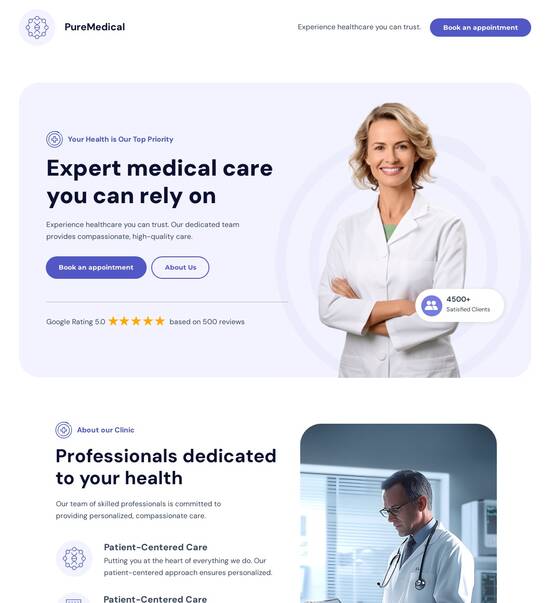
HTML page template for Business process managers
Use TemplateAbout template
Attract clients and showcase your skills with style using our landing page templates for Business process managers. Let's convert those visitors into clients!
Recommended templates

Easy to build without coding
With the intuitive drag-and-drop builder, anyone on your team can create high-converting pages without any knowledge of code or design. Make enhancements to your landing page with custom widgets using Javascript, HTML/CSS, or third-party scripts.

Multiple layouts for any industry and goal
Select from 500+ landing page layouts built to boost conversions across industry-specific scenarios. Customize them by adjusting fonts, adding images, and generating on-brand content with the AI assistant. Quickly scale with Instablocks® and Global Blocks that you can save, reuse, and update globally.

Loads fast and looks polished on any device
Every template is responsive, which means they present professionally on any device and load blazingly fast with our Thor Render Engine. You can also power them up with Google AMP technology to deliver an unparalleled mobile experience and drive higher conversions.

Robust analytics & experimentation
Get real-time updates and reporting across all your devices, showing the number of visitors, conversions, cost-per-visitor, and cost-per-lead. Launch AI-powered experiments, run A/B tests, and use heatmaps to analyze user behavior, then optimize your landing page to maximize conversions.







Easy to build without coding
With the intuitive drag-and-drop builder, anyone on your team can create high-converting pages without any knowledge of code or design. Make enhancements to your landing page with custom widgets using Javascript, HTML/CSS, or third-party scripts.
Multiple layouts for any industry and goal
Select from 500+ landing page layouts built to boost conversions across industry-specific scenarios. Customize them by adjusting fonts, adding images, and generating on-brand content with the AI assistant. Quickly scale with Instablocks® and Global Blocks that you can save, reuse, and update globally.
Loads fast and looks polished on any device
Every template is responsive, which means they present professionally on any device and load blazingly fast with our Thor Render Engine.
Robust analytics & experimentation
Get real-time updates and reporting across all your devices, showing the number of visitors, conversions, cost-per-visitor, and cost-per-lead. Launch AI-powered experiments, run A/B tests, and use heatmaps to analyze user behavior, then optimize your landing page to maximize conversions.
All the features you need to build lead-generating landing pages
Explore more featuresLearn how to build top-performing landing pages for any goal
FAQs
Leading the way in building high-performing landing pages





The ultimate guide to leveraging Instapage for enhanced landing page success
Instapage stands out as the leading landing page and conversion rate optimization (CRO) platform, designed to enhance digital marketing strategies. Businesses in diverse sectors, from tech to education, can maximize their campaign ROI by effectively using Instapage's features.
Understanding the power of Instapage
Instapage provides an all-in-one solution for marketers, making it easier to create optimized landing pages without requiring technical skills. The platform is equipped with over 100 high-converting templates and intuitive builders, allowing users to launch campaigns quickly and efficiently.
- Easy integration with existing marketing tools: Instapage seamlessly connects with popular marketing platforms, enhancing data analysis and team collaboration.
- High-conversion templates: Designed based on industry standards, these templates help improve lead generation and conversions.
- CRO features: With tools for A/B testing and detailed analytics, users can enhance their page performance continuously.
Step-by-step process to create landing pages with Instapage
Creating effective landing pages involves a strategic approach. Here’s how to get started:
- Choose a template: Select a high-converting template that aligns with your campaign goals.
- Customize your content: Use dynamic text replacement to personalize the messaging based on your audience.
- Publish and promote: Once satisfied, publish your page and leverage Instapage’s targeted ad features.
Optimizing for conversions
After publishing, it's critical to optimize your landing pages for maximum revenue. Consider these tactics:
- Implement A/B testing: Regularly test different headlines and calls-to-action to see what resonates best with your audience.
- Utilize heatmaps: Analyze user behavior on your page to identify areas of improvement.
- Track performance: Use the analytics dashboard to monitor the performance of your campaigns and make informed adjustments.
Utilizing the collaboration features of Instapage can also streamline the feedback process among team members.
With a robust platform like Instapage, marketers have the tools needed to transform their online campaigns effectively.
Start using Instapage today and discover how tailored landing pages can accelerate your marketing efforts. Sign up for a demo to see all the powerful features in action.
People also ask about HTML page template for Business process managers
HTML page template for business process managers
Understanding the landscape of HTML page templates for business process managers
In business process management, the digital environment plays a crucial role in enhancing efficiency and productivity. An organized digital workspace helps streamline various processes, making them more manageable and less time-consuming. HTML page templates emerge as valuable assets, providing a structured approach to creating consistent and professional-looking pages for a variety of business needs.
HTML page templates serve as a strategic advantage for business process managers. They provide a framework that allows for quick deployment of web pages, ensuring important information is presented clearly and effectively. By leveraging these templates, managers can not only save time but also elevate their team's output, allowing for a focus on more critical tasks at hand.
Core functions of HTML page templates
HTML page templates come with a variety of core functions tailored for business process managers. The emphasis on streamlining development processes is essential, considering the ever-evolving nature of technology and user expectations. They enhance collaboration among team members, making it easy to share and modify templates without complex coding requirements.
Enhanced collaboration among team members.
Reduction of repetitive coding tasks.
Customization options for specific business needs.
Moreover, the use of these templates drastically improves user experience (UX). A well-designed template ensures intuitive navigation, which is a critical aspect of keeping users engaged and satisfied. Templates increasingly incorporate responsive designs, allowing them to cater to the ever-growing range of devices used by customers and stakeholders alike.
In addition, integrating feedback mechanisms into templates allows for continuous user input, fostering an environment of constant improvement. This two-way communication can result in enhanced performance and usability of the templates themselves.
Innovative features of HTML templates for process managers
Innovative features of HTML templates contribute significantly to their utility for business process managers. One such feature is dynamic content loading with the DOMContentLoaded event, which plays a vital role in optimizing interactions within the template. It allows for important elements of a web page to load efficiently, enhancing overall user experience by reducing perceived load times.
Understanding the role of the DOMContentLoaded event in template interactions.
Examples of how this event can optimize user experience.
Tips for utilizing DOMContentLoaded effectively.
Another innovative feature is the utilization of document.addEventListener, which allows for robust interactivity. Understanding event handling is fundamental in creating engaging templates. Common use cases include detecting clicks on buttons, submitting forms, or dynamically altering user interface elements based on user input.
Providing step-by-step implementation guides for commonly used events can further enhance the usability of these templates. This can empower process managers to customize templates to meet their unique operational needs and streamline workflows.
Crafting tailored HTML templates for specific business needs
Crafting tailored HTML templates is essential for addressing the diverse operational structures within businesses. Customizing layouts specifically designed for project tracking, workflow management, and reporting can make a significant difference in how teams operate. The importance of modular design cannot be overstated, as it allows for easy adjustments as business requirements evolve.
Creating templates for project tracking.
Layout options for workflow management.
Reporting templates that summarize key metrics.
Incorporating branding elements smoothly into HTML templates is another vital aspect. Aligning templates with corporate identity not only strengthens brand consistency but also resonates with the targeted audience. Techniques include the strategic use of stylesheets and CSS, allowing for seamless integration of logos, colors, and fonts.
Additionally, SEO optimization plays a crucial role in enhancing the visibility of business processes online. Key elements such as structured data incorporation, meta tags, and alt text can significantly boost search engine rankings and drive more traffic to your pages.
The benefits of using HTML page templates
Utilizing HTML page templates offers numerous benefits, one of which is the cost-effectiveness in development. By reducing the overheads typically associated with custom development, businesses can allocate their resources more efficiently. Templates provide pre-designed elements and structures, substantially saving time during the development phase.
Reducing overheads associated with custom development.
Time saved through pre-designed elements.
Moreover, HTML templates facilitate agile methodologies, assisting teams in iterating improvements promptly. Sharing templates among team members fosters collaboration and communication, essential elements for achieving an efficient and productive workplace.
Lastly, enhanced security features are indispensable considerations when developing HTML templates. Issues such as securing data exchanges can be managed by following best practices, safeguarding the integrity of your business information.
Future trends in HTML templates for business process management
As business processes continue to evolve, so too do the technologies employed to manage them. One emerging trend is the rise of artificial intelligence in template customization. AI provides valuable insights regarding user behavior, enabling companies to enhance personalization by adapting templates based on user preferences and interactions.
How AI enhances user personalization.
Examples of AI-driven analytics for informed template tweaks.
Increased focus on accessibility is another important trend. Ensuring HTML templates are usable for all individuals requires adherence to established guidelines and standards. Businesses must prioritize compliance with accessibility standards such as WCAG to create inclusive digital environments.
Additionally, responsive design has become a standard requirement. As mobile usage increases, templates must be designed with a mobile-first approach to accommodate the diverse devices used by consumers today.
Case studies of successful HTML template implementation
Examining industry-specific examples showcases how various sectors leverage HTML templates for enhanced efficiency and effectiveness. For instance, the healthcare sector may use templates to simplify patient interactions and streamline administrative processes, leading to improved patient satisfaction.
How finance companies utilize templates to manage data securely.
Examples from tech companies using templates for agile project management.
Before-and-after analyses provide insights into the transformation businesses experience through template adoption. Significant operational improvements and productivity gains often stem from the proper implementation and customization of these templates.
Best practices for business process managers when using HTML templates
Maintaining a competitive edge requires regular updates to HTML templates to reflect business changes. Companies should establish protocols for routine reviews, allowing managers to adapt templates based on ongoing feedback and technological advancements.
Establishing protocols for template reviews.
Ensuring continual adaptation of templates.
Engaging team members in the customization process is vital. Strategies for gathering input from stakeholders and team members can lead to more effective templates. Furthermore, utilizing tools for collaborative feedback can provide additional insights on the effectiveness and usability of the templates.
Lastly, actively monitoring and evaluating template efficiency is essential to ensure performance metrics align with business objectives. Establishing key performance indicators (KPIs) to assess the success of your process management endeavors can help maintain the effectiveness of your HTML templates.
Ready to skyrocket conversions?
Supercharge your ad campaigns with high-performing landing pages
Get started














